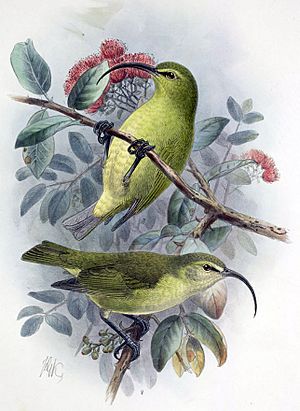Hemignathini facts for kids
Quick facts for kids Hemignathini |
|
|---|---|
 |
|
| Akialoa obscura | |
| Scientific classification |
|
| Kingdom: | Animalia |
| Phylum: | Chordata |
| Class: | Aves |
| Order: | Passeriformes |
| Family: | Fringillidae |
| Subfamily: | Carduelinae |
| Tribe: | Hemignathini |
| Genera | |
|
See text |
|
The Hemignathini were a special group of Hawaiian honeycreepers. These birds are famous for their unique beaks, which helped them find different kinds of food. They lived only in the beautiful Hawaiian Islands.
Sadly, many birds in this group are now extinct. This means they have completely disappeared from Earth. Others are known only from prehistoric times, meaning we only know about them from old bones or fossils.
Contents
Amazing Hawaiian Honeycreepers
Hawaiian honeycreepers are a type of bird found nowhere else in the world. Over millions of years, they changed and adapted to live in different parts of Hawaii. This led to many different species, each with its own special beak for eating nectar, insects, or seeds. The Hemignathini group included some of the most interesting honeycreepers.
Meet the Hemignathini Birds
This group of birds was once called a "tribe" by scientists. It included several different types of honeycreepers. Each type had unique features, especially their beaks, which helped them survive in their island homes.
The Aidemedia Birds
These birds had straight, thin beaks. They mostly ate insects. We only know about these birds from prehistoric times.
- Oʻahu icterid-like gaper (Aidemedia chascax) - This bird lived a very long time ago.
- Sickle-billed gaper (Aidemedia zanclops) - Another prehistoric bird.
- Maui Nui icterid-like gaper (Aidemedia lutetiae) - Also known from prehistoric times.
The Akialoa Birds
The Akialoa birds had long, curved beaks. Some had pointed beaks, while others had beaks that curved downwards. They ate both insects and nectar from flowers. Sadly, all Akialoa species are now extinct.
- Lesser ʻakialoa (Akialoa obscura) - Became extinct around 1940.
- Oʻahu ʻakialoa (Akialoa ellisiana) - Also became extinct around 1940.
- Maui Nui ʻakialoa (Akialoa lanaiensis) - Disappeared by 1892.
- Kauaʻi ʻakialoa (Akialoa stejnegeri) - Last seen around 1969.
- Hoopoe-billed ʻakialoa (Akialoa upupirostris) - This one is known from prehistoric times.
The Chlorodrepanis Birds
These birds have pointed beaks. They are still alive today! They eat both insects and nectar.
- Hawaiʻi ʻamakihi (Chlorodrepanis virens) - You can still see this bird in Hawaii.
- Oʻahu ʻamakihi (Chlorodrepanis flava) - Found on Oʻahu.
- Kauaʻi ʻamakihi (Chlorodrepanis stejnegeri) - Lives on Kauaʻi.
The Hemignathus Birds
The Hemignathus birds had pointed or long, downward-curved beaks. They mainly ate insects. This group includes the famous nukupuʻu and the ʻakiapolaʻau.
- Giant nukupuʻu (Hemignathus vorpalis) - A large prehistoric bird.
- Maui nukupuʻu (Hemignathus affinis) - Became extinct between 1995 and 1998.
- Oahu nukupuʻu (Hemignathus lucidus) - Disappeared by 1837.
- Kauai nukupuʻu (Hemignathus hanapepe) - Last seen in 1998.
- ʻAkiapolaʻau (Hemignathus wilsoni) - This unique bird is still alive. It uses its two-part beak to find insects in wood.
The Loxops Birds
These birds had small, pointed beaks. Their beak tips were slightly offset, which helped them eat insects.
- Hawaiʻi creeper (Loxops mana) - Still found in Hawaii.
- ʻAkekeʻe (Loxops caeruleirostris) - Another living species.
- Hawaiʻi ʻakepa (Loxops coccineus) - You can still find this bird.
- Maui ʻakepa (Loxops ochraceus) - Became extinct in 1988.
- Oʻahu ʻakepa (Loxops wolstenholmei) - Disappeared in the 1990s.
The Magumma Bird
This genus has only one species, the ʻAnianiau. It has a small, pointed beak and eats both insects and nectar.
- ʻAnianiau (Magumma parva) - A small, bright yellow bird still found on Kauaʻi.
The Oreomystis Bird
This genus also has one species, the ʻAkikiki. It has a short, pointed beak and eats insects.
- ʻAkikiki (Oreomystis bairdi) - This bird is critically endangered.
The Paroreomyza Birds
These birds had short, pointed beaks and mainly ate insects. This group includes the ʻalauahios and the kākāwahie.
- Maui Nui ʻalauahio (Paroreomyza montana newtoni) - A subspecies found on Maui.
- Lanaʻi ʻalauahio (Paroreomyza montana montana) - Became extinct in 1937.
- Kakawahie (Paroreomyza flammea) - Disappeared by 1963.
- Oʻahu ʻalauahio (Paroreomyza maculata) - Possibly extinct in the early 1990s.
The Vangulifer Birds
These birds had flat, rounded beaks. Scientists think they might have caught flying insects. They are only known from prehistoric times.
- Strange-billed finch (Vangulifer mirandus) - A prehistoric bird.
- Thin-billed finch (Vangulifer neophasis) - Another prehistoric bird.
The Viridonia Bird
This genus had only one species, the Greater ʻamakihi.
- Greater ʻamakihi (Viridonia sagittirostris) - Became extinct in 1901.
See also
 In Spanish: Carduelinae para niños
In Spanish: Carduelinae para niños

